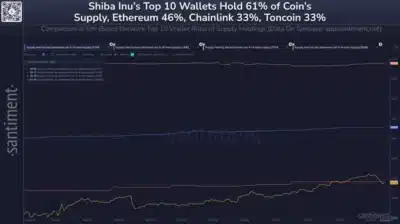According to Santiment, Shiba Inu’s top 10 wallets hold 61.3% of the total supply, raising concerns about market stability and centralization. This concentration level is significantly higher than other major cryptocurrencies, with Ethereum’s top 10 wallets controlling 46.1%, Chainlink’s 33.1%, and Toncoin’s 32.8%.
The data suggests that a few holders have substantial influence over the market, leading to potential risks such as price manipulation and sudden volatility.
Also Read: SEC Moves Closer to Approving ETFs for XRP, Solana, and Litecoin
Experts Warn of Volatility Due to Supply Centralization
The cryptocurrency market experiences stable prices based on the choices made by major wallet holders, according to the data from Santiment. Large crypto holders who choose to dispose of their ownership usually trigger a steep market price drop, which automatically poses a disadvantage to retail investors.
On the other hand, when these investors retain their assets, it boosts market confidence, consequently stabilizing the market.
The high concentration of investor wallets leads the market to experience price changes mainly through the actions of a few major holders. Professional investors gain control over price movements because of the higher certainty that retail investors experience.
Cryptocurrency markets benefit from distributed supply networks when they reduce major wallet dominance while building a price forecast framework that is easier to predict.
Comparison of Shiba Inu’s Centralization with Other Cryptocurrencies
The analysis from Santiment shows Shiba Inu ranks highly as a centralized cryptocurrency compared to other leading altcoins because the top holder controls 61.3% of the total supply. The top 10 wallets in Ethereum hold 46% of the blockchain network’s supply even though it remains one of the leading networks.
While this shows some centralization compared to other digital currencies, it is more balanced than Shiba Inu. Meanwhile, Chainlink and Toncoin, with 33.1% and 32.8% supply concentration respectively, demonstrate a more even distribution of holdings.
A lower concentration typically means less risk of sudden price swings, as no single entity has enough control to manipulate the market significantly. This gives smaller investors more confidence in the long-term stability of the asset.

Source: @santimentfeed
How Supply Concentration Affects Investor Confidence
According to Santiment, a high concentration of supply in a few wallets presents risks and potential opportunities. The risks include higher volatility, as any significant sell-off from large holders could cause a rapid price drop, leaving smaller investors with substantial losses.
It also increases the likelihood of market manipulation, as these key players have the power to impact price movements significantly.
However, if these top holders continue to accumulate or hold, it suggests a long-term belief in the asset’s value. This can provide stability and attract more investors, but the market remains heavily dependent on their actions.
Investors should remain cautious about assets where a small group controls the majority of supply, as sudden changes in their trading behavior can disrupt market conditions.
Decentralization as a Key Factor in Market Stability
According to Santiment, a more decentralized supply structure, like Chainlink and Toncoin, is healthier for cryptocurrency markets. When supply is distributed among many investors rather than concentrated in a few wallets, it minimizes the risks of sudden sell-offs and price manipulation.
This ensures that price movements are more organic, reducing extreme volatility. For Shiba Inu, the high level of supply concentration raises concerns about future price stability. While whale activity can maintain short-term stability, it leaves the asset vulnerable to unexpected market shifts. I
If a large holder decides to exit the market, it could trigger a chain reaction of selling, causing rapid price drops and panic among retail investors.
Why Investors Should Monitor Wallet Distribution
As per the Santiment report, tracking supply distribution is crucial for investors to assess a cryptocurrency’s long-term stability and risk level. Shiba Inu’s current concentration means that price movements are highly dependent on a small number of wallets, making it a riskier asset than more decentralized alternatives.
Investors can make informed decisions about potential risks and market behavior by analyzing wallet concentration across different cryptocurrencies, such as Ethereum, Chainlink, and Toncoin.
As the crypto industry evolves, monitoring whale activity and supply distribution will continue to be essential for evaluating digital assets’ stability and prospects.
Also Read: Shibarium Gains Traction as Daily Transactions Reach New Heights in 2025

